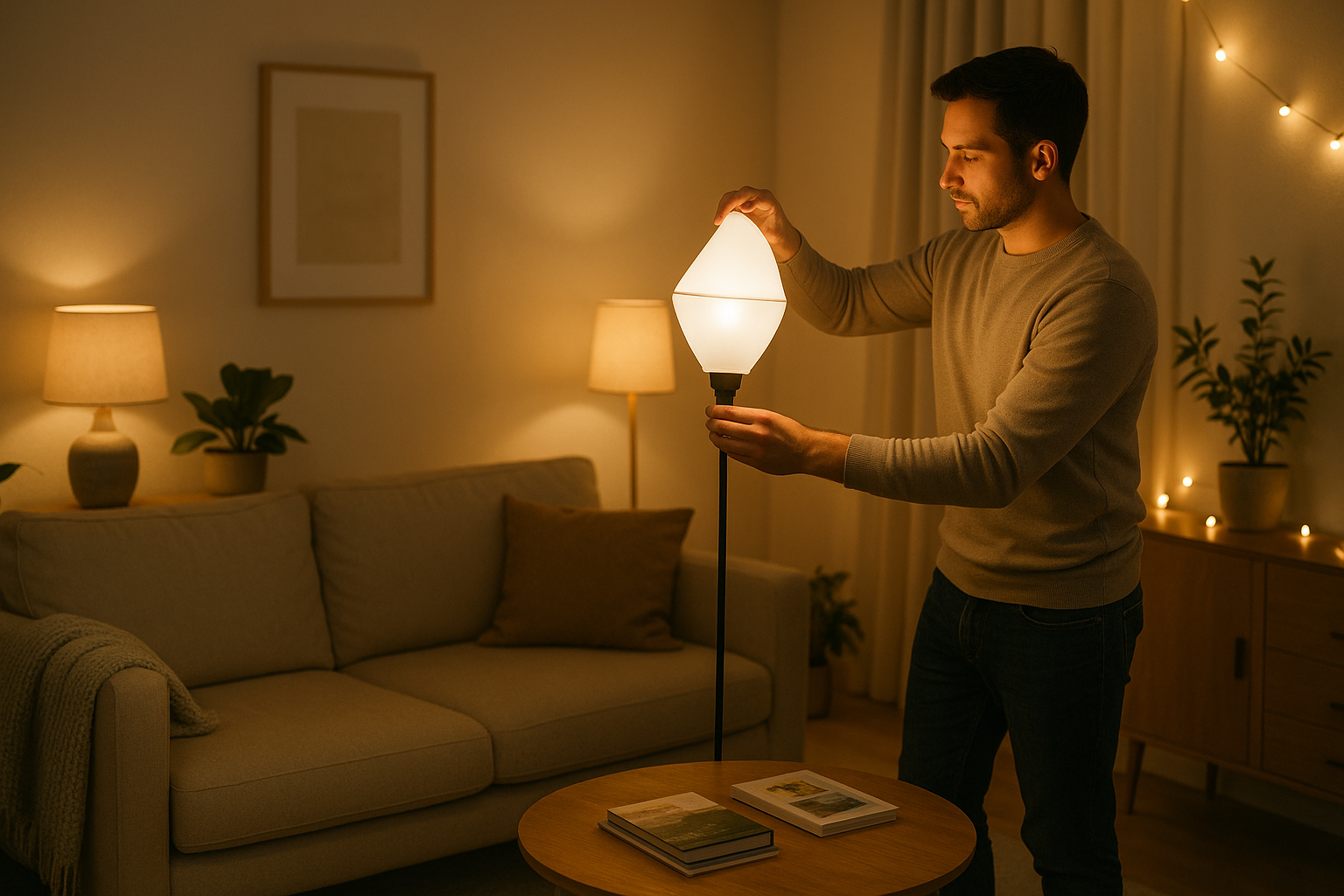In a world that seems to be constantly on the go, finding time to create a space that not only feels inviting but also exudes a certain je ne sais quoi, can often feel like a Herculean task. But what if I told you, with a few simple DIY soft lighting techniques, you can transform any space into an oasis of calm and tranquility in mere minutes? 😮 Intriguing, isn’t it?
Lighting, in its myriad forms, has the uncanny ability to dictate mood, atmosphere, and even our perceptions of a space. It can turn a sterile, cold room into a cozy nook perfect for curling up with a good book 📚, or a nondescript backyard into a magical wonderland 🌌 perfect for late-night soirees. Yet, its importance is often relegated to an afterthought, a final touch to an already designed space. In this article, we will delve into the art and science of DIY soft lighting techniques that promise to elevate any space from the mundane to the magical.
Before we delve into the how, let’s take a moment to understand the why. Why is lighting important? And more specifically, why soft lighting? At its core, soft lighting is all about diffusing light to minimize harsh shadows and create a gentle, inviting glow. It’s the key to instant ambiance, creating a warm, enveloping atmosphere that is both soothing and welcoming. Not to mention, it’s easy on the eyes.
From pendants to wall sconces, floor lamps to fairy lights, there is a plethora of lighting options available that can cater to your unique aesthetic and functional needs. However, choosing the right lighting can often feel like navigating a labyrinth with its myriad choices and technical jargon. Fear not! We’ll guide you through this lighting maze with practical, hands-on advice and techniques that are easy to implement and require no prior technical expertise.
As we navigate through this illuminating journey, we will explore topics such as the role of color temperature in creating ambiance, how to use layers of light to create depth and drama, and even the principles of shadow play. We will also walk you through simple, easy-to-follow DIY soft lighting projects that can be completed in less than an hour but will have a lasting impact on your space. Whether you’re a novice DIYer dipping your toes into the world of home decor or a seasoned pro looking for fresh inspiration, this article promises to enlighten and inspire. So, let’s flip the switch and illuminate your space in minutes! 💡
So, without further ado, let’s dive right into the heart of the matter and shed some light on the transformative power of DIY soft lighting techniques.
Understanding Soft Lighting: What it is and Why it Matters
🔍 Light plays a crucial role in creating an environment. Whether it’s your home, workspace, or a social event, lighting sets the mood and atmosphere. One of the most versatile lighting techniques that can dramatically change a space is soft lighting.
Soft lighting, also known as diffuse lighting, refers to light that has been scattered across a large area. This technique reduces harsh shadows and contrast, creating a more relaxed, welcoming ambiance. It is widely used in photography, cinematography, and interior design to portray warmth, openness, and calmness.
Now, let’s take a closer look at how soft lighting compares to its counterpart – hard lighting.
Soft Lighting vs. Hard Lighting
| Lighting Type | Features | Effects |
|---|---|---|
| Soft Lighting | Light is diffused or spread out over a larger area. It minimizes shadows and contrast. | Creates a calm, warm, and inviting atmosphere. Ideal for relaxed, intimate settings. |
| Hard Lighting | Light is concentrated in a narrow beam. It creates stark shadows and high contrast. | Creates drama and intensity. Often used for emphasis and highlighting specific objects. |
Interested in seeing this contrast in real life? Check out the video ‘Hard Light vs. Soft Light: The Basics of Lighting for Beginners’ on the YouTube channel ‘The Slanted Lens’.
DIY Soft Lighting Techniques: Illuminating Your Space in Minutes
💡 So, how can you incorporate soft lighting into your space? Thankfully, it’s a lot simpler than it sounds. There are numerous DIY soft lighting techniques that you can easily implement, even with a limited budget. Here are a few to get you started:
Use Diffusion Materials
Diffusion materials spread out light, creating a softer effect. You can use a wide variety of materials for this purpose, such as translucent plastic sheets, thin white fabrics, or even parchment paper. Place these materials over your light sources to diffuse the light and soften the ambiance.
Experiment with Reflectors
Reflectors bounce light off surfaces, diffusing it in the process. You can use a commercial photography reflector or improvise with items you have at home, like aluminum foil or a white board.
Play with Light Positioning
The position of your light source can significantly impact the softness of the light. Placing the light source closer to your subject will make the light softer, while moving it further away will create harder light.
Want to see these techniques in action? I highly recommend watching the video ‘How to Create Soft Light in a Small Space’ by the YouTube channel ‘Aputure’.
Choosing the Right Lighting Equipment for Soft Lighting
🔧 If you’re serious about achieving the perfect soft lighting, investing in the right equipment can be a game changer. Here’s a quick rundown on the essential gear you’ll need.
Softbox Lights
Softbox lights are designed to produce soft, even lighting. They have a reflective interior and a diffusion material front, effectively spreading out the light they produce. Softbox lights are a staple in professional photography and cinematography, but they’re also great for home use.
Umbrella Lights
Umbrella lights are another popular choice for soft lighting. They work by bouncing light off their interior surface, diffusing it across a wide area. They’re relatively inexpensive and easy to use, making them a great option for beginners.
LED Panel Lights
LED panel lights are versatile lighting tools that can be adjusted to produce either hard or soft light. They’re energy-efficient, long-lasting, and provide consistent light output, making them a reliable option for your lighting needs.
Check out the comparative table below to help you choose the right equipment for your needs.
| Lighting Equipment | Pros | Cons |
|---|---|---|
| Softbox Lights | Produces soft, even light. Available in various sizes. | Can be bulky and difficult to set up. |
| Umbrella Lights | Inexpensive and easy to use. Good for bouncing light. | Not as controllable as other lighting options. |
| LED Panel Lights | Versatile, energy-efficient, and durable. Adjustable light hardness. | Can be expensive. Some models may produce uneven light. |
For a detailed review of these lighting tools, don’t miss the video ‘Best Lighting for YouTube Videos’ on the YouTube channel ‘Think Media’.
Final Thoughts
🌟 Soft lighting is an amazing tool that can instantly transform any space, creating a warm, inviting ambiance. With a basic understanding of light and a few simple techniques, you can easily incorporate soft lighting into your own environment.
So, what are you waiting for? Light up your space and see the difference!
For more tips and techniques on DIY soft lighting, don’t forget to subscribe to the ‘DIY Lighting Hacks’ playlist on the YouTube channel ‘Aputure’.

Conclusion
In conclusion, we’ve navigated through a myriad of technical details and complex concepts, shedding light on their relevance in the practical world. From the initial stages of understanding the core of IT and engineering, to the intricate nuances of software engineering, the journey has been nothing short of enlightening. 🧠💡
Undoubtedly, we have delved into some highly specialized areas, however, the aim was to present these technical topics in a way that’s comprehensible, regardless of your technical background. The goal was to bridge the gap between the experts and the layman, making tech knowledge more accessible to all. 💼🌉
We began by exploring the ins and outs of IT, understanding its significance in our digital age. We further delved into the world of engineering, comprehending how it forms the backbone of any technological innovation. And finally, we navigated through the complex world of software engineering, understanding its indispensability in the era of digital transformation. 🌐💻
It’s essential to understand that every technological innovation or digital transformation we witness today is built upon the solid foundation of IT and engineering. These fields are not just mere technical jargon; they hold real-world implications, driving our progress towards a tech-powered future. 🚀🌟
So, whether you are an expert, a beginner, or simply a tech enthusiast, embracing these complex yet vital aspects of our digital world is imperative. It not only aids in your professional growth but also contributes to your personal knowledge and understanding. 📈🎯
Moreover, the insights and understanding derived from these fields can potentially open up new avenues for innovation, providing you with the tools to contribute to our collective tech-driven future. So, continue to explore, learn, and grow with these technical fields and you’ll soon realize their transformative power. 🔧🔬
Lastly, remember that the goal of this technical writing is to simplify and explain, not to confuse. Hence, always feel free to share your thoughts, questions, or comments. 📝✉️
Whether it’s a critique, a query, or an appreciation, every single interaction helps in refining the content, making it more engaging and beneficial for all. Therefore, don’t hesitate to comment below, share with your peers, or apply the knowledge gained in your respective fields. 💬💡
Your contribution can make a difference, inspiring others to explore these technical fields, thereby propagating a culture of learning and understanding. Remember, every giant leap towards our tech-future begins with small steps of learning today. 🚶♂️🌱
I invite you to continue this technical journey with me. For further reading, you can check the following articles:
– Software Engineering
– IT and Engineering
And always remember: The world of IT and Engineering is vast and complex, but that’s what makes it so fascinating and rewarding. So, never stop exploring, learning, and innovating. 🌎📘
Tags: #IT, #Engineering, #SoftwareEngineering


